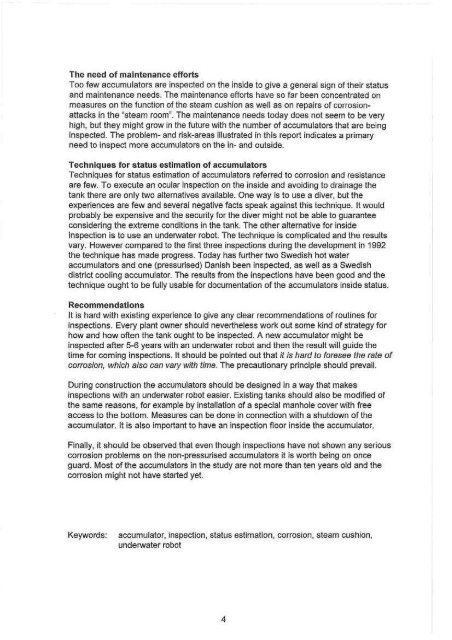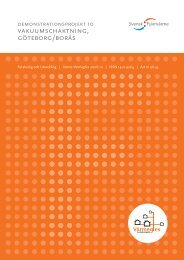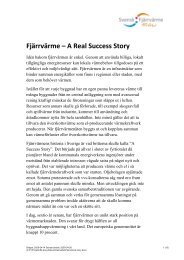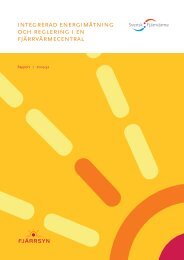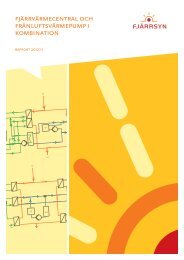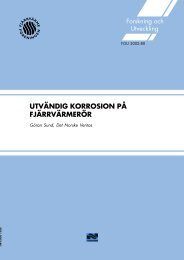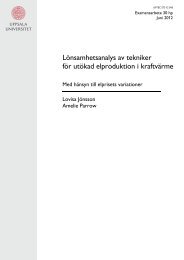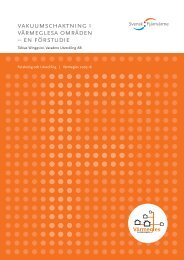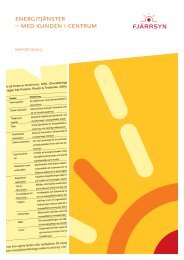statusrapport trycklösa hetvattenackumulatorer - Svensk Fjärrvärme
statusrapport trycklösa hetvattenackumulatorer - Svensk Fjärrvärme
statusrapport trycklösa hetvattenackumulatorer - Svensk Fjärrvärme
You also want an ePaper? Increase the reach of your titles
YUMPU automatically turns print PDFs into web optimized ePapers that Google loves.
The need of maintenance ettorts<br />
Too few accumulators are inspecled on the inside to g i ve a general sign of their status<br />
and maintenance needs. The maintenance efforls have so far been concentrated on<br />
measures on the function of the steam cushion as well as on repairs of corrosionattacks<br />
in the "steam mom". The maintenance needs loday does not seem to be very<br />
hrgh, but they mrght grow in the future with Jhe number of accumulators that are bemg<br />
inspected. The problem- and risk-areas illustrated In this report indicates a primary<br />
need to inspect more accumulators on the in- and outside.<br />
Techniques for status estimation of accumufators<br />
Techniques for status estimation of accumufators referred to corrosion and resistance<br />
are few. To execute an ocular inspection on the inside and avoiding to drainage the<br />
tank there are only two altematrves available. One way is to use a diver, but the<br />
experiences are few and several negative facts speak against this technique. I! would<br />
probably be expensive and the security for the diver mig ht not be able to guarantee<br />
considering the extreme conditions in The tank. The other alternative for inside<br />
inspection is to use an underwater robot. The technique is complicated and the results<br />
vary. However compared to the first three inspedions during the development in 1992<br />
the technique has made progress. Today has furiher two Swedish hot water<br />
accumulators and o ne (pressurised) Danish been inspected. as well as a Swedish<br />
district coolino. aocumulator. The results from the inspectlons have been good and the<br />
technique ought to be ful I v usable for documentaTion of the accumulators ms ide status.<br />
Recom m e nd ati o n s<br />
It is härd with existlng experlence to give any cTear recommendations of routines for<br />
inspections. Every plant owner should ne vert heless work out so me kind of strategy for<br />
how and how oflen the tank ought to be inspected. A new accu mulator mig ht be<br />
inspected after 5-6 years wtth an underwater robot and then the result will guide the<br />
time for coming inspections. It should be pointed out that it is härd to foresee the rafe of<br />
corrosion, which also can vary with time. The precautionary principle should prevail,<br />
During construction the accumulators should be designed in a way that makes<br />
inspections with an underwater robot easier\ Exisling tanks shouid also be modified of<br />
the same reasons, for example by Installation of a special manhole cover with free<br />
access to the bottom. Measures can be done in connection with a shutdown of the<br />
accumulator. It is also important to have an inspection floor inside the accumulator.<br />
Finally, it should be observed that even though [nspedions have not shown any senous<br />
corrosion problems on the non-pressurised accumulators it is worTh being on once<br />
guard, Most of the accumulators in the study are not more than ten years old and the<br />
corrosion might not have started yet.<br />
Keywords: accumulator, rnspedion, status estimation, corrosron, steam cushfon,<br />
underwater robot


